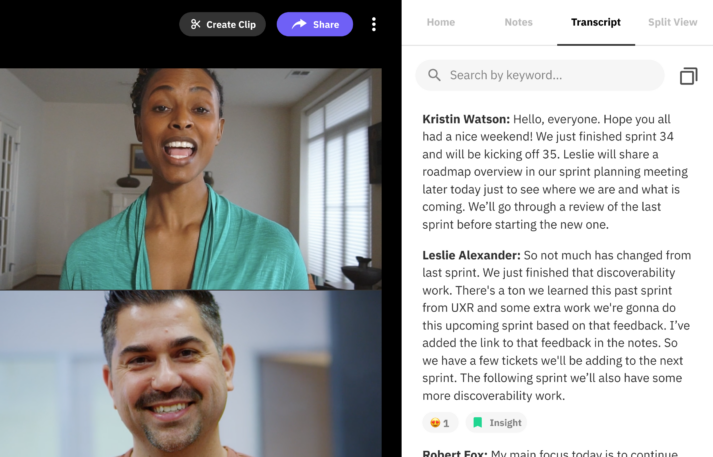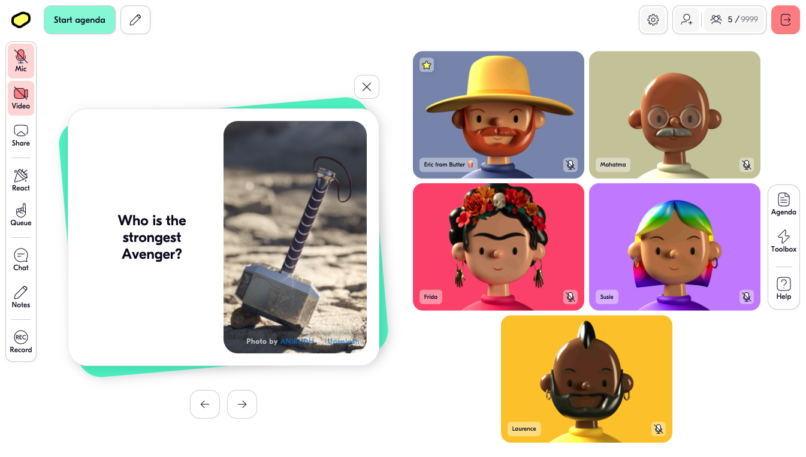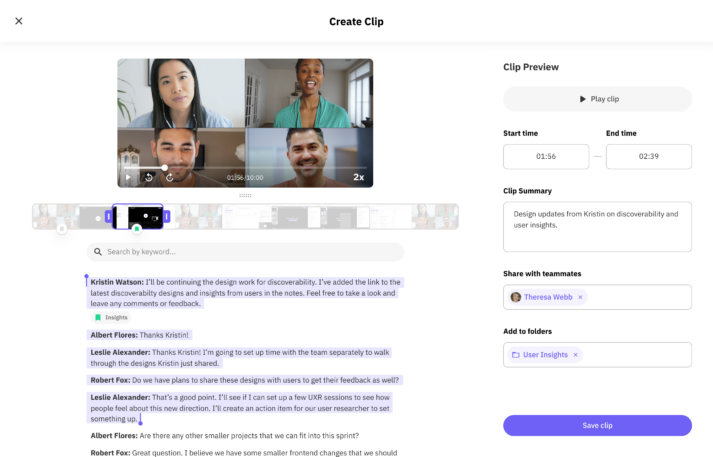If it were up to me, I’d have all my video calls in an app like Vowel.
Compared to the likes of Zoom and Microsoft Teams, Vowel makes meetings more useful and enjoyable. It provides a shared scratchpad for notes and action items, lets you block out time limits for each discussion topic, and automatically generates a searchable transcript at the end.
Alas, I’m usually not the decision maker when it comes to virtual meeting venues, and so back to Zoom I inevitably go.
Vowel is part of a new wave of startups that want to rethink videoconferencing yet again. Alongside others such as Butter, Switchboard, and Around (which was acquired by whiteboard service Miro last month), these companies believe the video chat tools we hastily adopted during the pandemic aren’t all that helpful for productivity.
Still, disrupting the giants of video chat will require reckoning with three years’ worth of expectations, design conventions, and inertia. Getting people to try something new could be a slog.
Doing what Zoom doesn’t
As the makers of alternative video chat tools tell it, they’re about more than just talking.
“Zoom, it allows you to see and hear each other, but it doesn’t really allow you to collaborate and get work done,” says Andy Berman, Vowel’s CEO and cofounder.

With Vowel, users can add shared agenda items to meetings before they begin, and they’ll appear in a sidebar while the meeting’s in progress. The app also offers a shared scratchpad for meeting notes, and it lets participants bookmark important moments or insightful comments along the way.
After the meeting, Vowel offers a searchable meeting transcript, and clicking on the text plays back the corresponding portion of the video. Bookmarks and emoji reactions also appear in the video timeline, making them easier to revisit.

“We let users time travel to their company’s most valuable asset: the time people spend together,” Berman says.
While Vowel’s real value emerges after the meeting is over, many of these Zoom alternatives also aim to enhance the meeting itself.

Both Vowel and Butter, for instance, let users set up countdown timers for each agenda item before the call starts, and the latter tool aims to make meetings more engaging with interactive flash cards and polls. Switchboard provides a sprawling canvas with a built-in web browser, letting users jointly collaborate inside Notion, Figma, and other web apps. And in Around, participants appear as chat bubbles in an onscreen overlay to free up space for other tasks. (Its acquisition by Miro in October suggests a future in interactive whiteboarding.)
Jakob Knutzen, Butter’s CEO and cofounder, says the goal with these kinds of features is to be more intentional about meetings and better-serve specific uses.
“It’s the third generation, of which Butter would be one of whom, which is making it more focused, and which is making it less about video chat than about the use case of whatever you’re using it for,” he says.
More than a plug-in
That’s not to say video chat behemoths are ignoring specific use cases. Both Zoom and Microsoft Teams have their own app stores that can integrate tools such as Figma and Miro into video calls. Google Meet is also getting third-party app integrations next year.

But the makers of Zoom alternatives argue that those add-ons are too cumbersome for users and too restrictive for developers. Knutzen says that while he considered launching Butter as a plug-in for Zoom instead of a standalone app, he ultimately decided against it.
“All startups that I’ve spoken with that have built an app on top of Zoom, they’ve said that the Zoom API is too slow-moving or too problematic for them to work with to build a business on,” he says.
The bigger risk is that companies like Zoom may just duplicate features from smaller providers, without making users install extra apps or plugins. To wit: Zoom just announced a “Smart Recordings” feature with searchable transcripts, automated chapters, and highlights. Those are the kinds of post-meeting tools on which Vowel has built its business.
Still, Berman is undeterred. Vowel’s customers consistently say that Zoom feels clunky, and he believes the company is more focused on selling to large enterprises than solving problems for users.

“While Zoom can release any one feature here and there, they have yet to show the aptitude for collaborative cohesion across all their features,” Berman says.
Knutzen also brushes off the danger of being copied by the likes of Zoom and Microsoft Teams. They’re ultimately too slow-moving, he says, so they can’t easily adapt their products to meet specific needs.
“Zoom and Meet and Teams, they’re all great generalist platforms, and they will continue to be for a very long time,” he says, “but when it comes to individual use cases, they would dilute their own platform and dilute their own focus too much if they were to build something for every single use case.”
Breaking old habits
Even if startups such as Vowel and Butter can build better products than Zoom, success is hardly guaranteed.
For one thing, inertia is an ever-present challenge, one that Knutzen says he underestimated at the outset. While getting people to switch is, in theory, just a matter of swapping out one meeting link for another, the reality is that people are used to Zoom and reluctant to try something different.
“There are just a lot of habits that have built up over a long period of time, even of button placement and things like that,” he says. “We’re working against those habits and trying to challenge them. That’s super hard.”
Mike Fasciani, a senior director analyst at Gartner, notes that business may also not be willing to take a chance on newer video chat vendors. They may have questions about reliability, for instance, or about their ability to integrate with teleconferencing hardware.
“They’re usually not likely to take risks on smaller, little niche vendors unless it’s for a niche requirement,” he says. “These days, virtual meetings are not a niche requirement.”
Meanwhile, the big video chat providers are trying to make switching platforms even more of a burden for teams. Zoom, for instance, has been pushing a broader suite of products, including chat rooms and call center integration, and it now has built-in email and calendar clients to encourage more time spent in the Zoom app. That in itself is an answer to Microsoft and Google, both of which integrate video chat into the broader productivity suites that companies are already paying for.

“It’s a very wide moat,” Fasciani says. “It’s not very deep, because neither of those vendors are best in breed for much of what they do, but it’s such a wide moat because they do so much, it’s hard to swim across it.”
For now, companies like Vowel and Butter hope to take a page from the likes of Notion and Coda, which have upended the document editor by refashioning it as a tool for project management. Like those companies, their goal is to win over small, tech-savvy teams first before targeting larger businesses.
“Who adopts in an organization today? Product, design, and engineering teams. They’re the people that have the ability to choose their own tools,” Berman says. “They’re the makers. They’re the people in meetings that have to actually collaborate with each other.”
With any luck, perhaps my editors and any PR folks reading this will decide to try something different as well.
Recognize your brand’s excellence by applying to this year’s Brands That Matter Awards before the early-rate deadline, May 3.